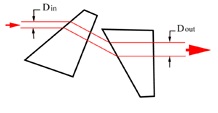product origin:
Chinashipping port:
Fuzhou Chinalead time:
4 working weekspayment:
T/T Payment, Western Union1. What it anamorphic prism?
Anamorphic prisms are used to correct the asymmetric, elliptical beams produced by laser diodes, so that the beams are nearly circular in shape.
2.What is the advantages of anamorphic prism?
The ability of adjusting the position of the prisms allows the user to compensate for variations from one light source to another.
The prisms are more cost effective than cylindrical lenses of comparable quality.


Specifications:
Material: N-SF11 Grade A optical glass
Dimension Tolerance: +0.0, -0.2 mm
Clear Aperture: >80%
Flatness: l/8 @633 nm
Theta: q = 29°27±3"
Surface Quality: 60-40 scrach and dig
Coating: MgF2 single layer on perpendicular surface
Copyright © UNI OPTICS CO., LTD © All Rights Reserved.